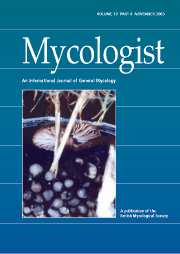Crossref Citations
This article has been cited by the following publications. This list is generated based on data provided by
Crossref.
Blackwood, Christopher B.
Oaks, Adam
and
Buyer, Jeffrey S.
2005.
Phylum- and Class-Specific PCR Primers for General Microbial Community Analysis.
Applied and Environmental Microbiology,
Vol. 71,
Issue. 10,
p.
6193.
Vasiliauskas, Rimvydas
Lygis, Vaidotas
Larsson, Karl-Henrik
and
Stenlid, Jan
2005.
Airborne fungal colonisation of coarse woody debris in North Temperate Picea abies forest: impact of season and local spatial scale.
Mycological Research,
Vol. 109,
Issue. 4,
p.
487.
Hausner, Georg
and
Wang, Xi
2005.
Unusual compact rDNA gene arrangements within some members of the Ascomycota: evidence for molecular co-evolution between ITS1 and ITS2.
Genome,
Vol. 48,
Issue. 4,
p.
648.
Råberg, Ulrika
Edlund, Marie-Louise
Terziev, Nasko
and
Land, Carl Johan
2005.
Testing and evaluation of natural durability of wood in above ground conditions in Europe – an overview.
Journal of Wood Science,
Vol. 51,
Issue. 5,
p.
429.
Fernandes, P.
2006.
Applied microbiology and biotechnology in the conservation of stone cultural heritage materials.
Applied Microbiology and Biotechnology,
Vol. 73,
Issue. 2,
p.
291.
Mitchell, Julian I.
and
Zuccaro, Alga
2006.
Sequences, the environment and fungi.
Mycologist,
Vol. 20,
Issue. 2,
p.
62.
Martin, Kendall J.
2007.
Introduction to Molecular Analysis of Ectomycorrhizal Communities.
Soil Science Society of America Journal,
Vol. 71,
Issue. 2,
p.
601.
Thies, Janice E.
2007.
Soil Microbial Community Analysis using Terminal Restriction Fragment Length Polymorphisms.
Soil Science Society of America Journal,
Vol. 71,
Issue. 2,
p.
579.
Bärlocher, Felix
2007.
Molecular approaches applied to aquatic hyphomycetes.
Fungal Biology Reviews,
Vol. 21,
Issue. 1,
p.
19.
Guglielmo, F.
Bergemann, S.E.
Gonthier, P.
Nicolotti, G.
and
Garbelotto, M.
2007.
A multiplex PCR-based method for the detection and early identification of wood rotting fungi in standing trees.
Journal of Applied Microbiology,
Vol. 103,
Issue. 5,
p.
1490.
Mullineux, Taylor
and
Hausner, Georg
2009.
Evolution of rDNA ITS1 and ITS2 sequences and RNA secondary structures within members of the fungal genera Grosmannia and Leptographium.
Fungal Genetics and Biology,
Vol. 46,
Issue. 11,
p.
855.
Bärlocher, Felix
2010.
Molecular approaches promise a deeper and broader understanding of the evolutionary ecology of aquatic hyphomycetes.
Journal of the North American Benthological Society,
Vol. 29,
Issue. 3,
p.
1027.
Schneider, S.
Hartmann, M.
Enkerli, J.
and
Widmer, F.
2010.
Fungal community structure in soils of conventional and organic farming systems.
Fungal Ecology,
Vol. 3,
Issue. 3,
p.
215.
Nicolotti, Giovanni
Gonthier, Paolo
and
Guglielmo, Fabio
2010.
Molecular Identification of Fungi.
p.
251.
Klaubauf, Sylvia
Inselsbacher, Erich
Zechmeister-Boltenstern, Sophie
Wanek, Wolfgang
Gottsberger, Richard
Strauss, Joseph
and
Gorfer, Markus
2010.
Molecular diversity of fungal communities in agricultural soils from Lower Austria.
Fungal Diversity,
Vol. 44,
Issue. 1,
p.
65.
Marano, Agostina V.
Gleason, Frank H.
Bärlocher, Felix
Pires-Zottarelli, Carmen L.A.
Lilje, Osu
Schmidt, Steve K.
Rasconi, Serena
Kagami, Maiko
Barrera, Marcelo D.
Sime-Ngando, Télesphore
Boussiba, Sammy
de Souza, José I.
and
Edwards, Joan E.
2012.
Quantitative methods for the analysis of zoosporic fungi.
Journal of Microbiological Methods,
Vol. 89,
Issue. 1,
p.
22.
Scholz-Starke, B.
Beylich, A.
Moser, T.
Nikolakis, A.
Rumpler, N.
Schäffer, A.
Theißen, B.
Toschki, A.
and
Roß-Nickoll, M.
2013.
The response of soil organism communities to the application of the insecticide lindane in terrestrial model ecosystems.
Ecotoxicology,
Vol. 22,
Issue. 2,
p.
339.
Langarica-Fuentes, Adrian
Handley, Pauline S.
Houlden, Ashley
Fox, Graeme
and
Robson, Geoffrey D.
2014.
An investigation of the biodiversity of thermophilic and thermotolerant fungal species in composts using culture-based and molecular techniques.
Fungal Ecology,
Vol. 11,
Issue. ,
p.
132.
Dannemiller, Karen C.
Reeves, Darryl
Bibby, Kyle
Yamamoto, Naomichi
and
Peccia, Jordan
2014.
Fungal High‐throughput Taxonomic Identification tool for use with Next‐Generation Sequencing (FHiTINGS).
Journal of Basic Microbiology,
Vol. 54,
Issue. 4,
p.
315.
Rosado, Tânia
Dias, Luís
Lança, Mónica
Nogueira, Carla
Santos, Rita
Martins, Maria Rosário
Candeias, António
Mirão, José
and
Caldeira, Ana Teresa
2020.
Assessment of microbiota present on a Portuguese historical stone convent using high‐throughput sequencing approaches.
MicrobiologyOpen,
Vol. 9,
Issue. 6,
p.
1067.


